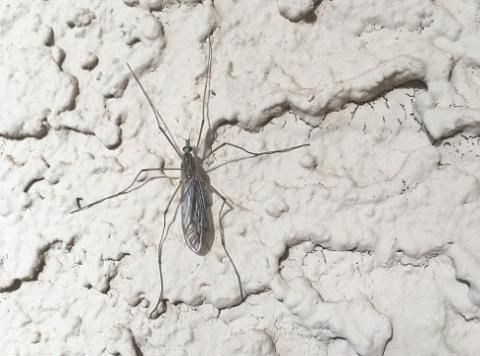
Crane Flies
Image credit: Shujuan (Lucy) Li. An adult crane fly resting on the ground at Maricopa Agricultural Center.
Crane Flies, not Giant Mosquitoes
As the weather warms up, residents in Arizona start to notice giant insects landing or flying around our homes or offices. People call them giant mosquitoes, but these gentle giants are not mosquitoes at all. They are actually crane flies and are harmless.
Crane fly, a member of the fly family Tipulidae (order Diptera, meaning two-winged insects), looks like a mosquito, but is not a mosquito. Crane flies have a slender mosquito-like body and extremely long legs. Adult crane flies can range from tiny to almost 1.2 inches long. These slow-flying insects are harmless and usually found around water or among abundant vegetation.
Crane fly adult females generally deposit their eggs in damp areas or in grass. Lawns near wooded areas or open fields often have a population of crane flies. Dampness and heavy rainfall can increase their numbers. Each egg hatches into a long slender larva, called a leather jacket due to its tough brown skin. Only in their larval stage do crane flies cause any potential damage. The larvae usually feed on decaying plant tissue, and damage the roots of cereal and grass crops, sometimes leaving large brown patches on lawns, but generally are beneficial soil dwellers feeding on organic matter. The larvae feed all winter, followed by a resting stage in the spring. The adults generally show up in late winter or early spring, occasionally in large numbers. Adult crane flies generally do not feed, though some species may take nectar from flowers.
Adult crane flies are attracted to lights and often annoy residents when they fly into homes and bump against walls or ceilings. Although they look like giant mosquitoes, they do not bite people or feed on blood because they don’t have the sucking mouth parts that mosquitoes have. Mature crane flies only live up to two weeks, long enough to complete their reproductive cycle. Residents may see or observe dead adult crane flies on grounds around homes and buildings shortly after their lifecycle has completed.



